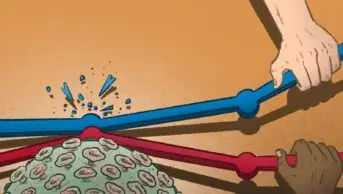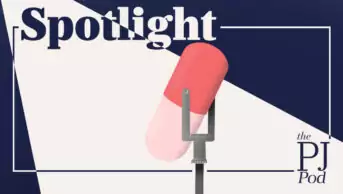
Shutterstock.com
It has been known for some time that white students are more likely to go on to receive better degrees within the UK higher education system, compared with their minority ethnic counterparts.
The Office for Students reports a gap of more than 18 percentage points for the proportion of black students getting a first or upper second class degree, and a gap of 8 percentage points for Asian students[1].
There is evidence that this gap also exists for pharmacy degrees. In July 2020, The Pharmaceutical Journal reported data from 2017/2018 and 2018/2019 on the number of students who graduated with an MPharm degree and had a recorded ethnicity. Overall, 91% of white students were awarded first class or upper second class honours, compared with 79% of ethnic minority students over the same time period.
There is some national evidence that this awarding gap may have reduced in more recent years, with adaptations made to the awarding of degrees during the COVID-19 pandemic, but regardless, the presence of such a gap limits the life chances of students from ethnic minority groups and it is everyone’s responsibility to do all they can to reduce it[2].
In light of this, in September 2020, the pharmacy department at the University of Sussex independently funded a race equity programme to combat the awarding gap, by creating a learning environment in which black, Asian and minority ethnic (BAME) students could thrive.
Developing a race equity plan
Often, the awarding gap stems from a lack of representation in teaching positions, a sense among ethnic minority students of ‘not belonging’ and the content of the curriculum being non-inclusive, alongside a lack of information, guidance and advice for minority ethnic groups.
The aim of the race equity programme was to enhance the academic experience of students in relation to performance and sense of belonging. Through the programme, we wanted to recognise and highlight the challenges faced by BAME students and introduce changes to meet those specific needs.
As Race Equity Advocates (REAs), our role was to convey the lived experiences, needs and ideas of BAME pharmacy students directly to leadership teams.
This included organising drop-in sessions to meet students’ needs, in collaboration with students and staff, and attending school-level meetings to share the learnings from pharmacy initiatives so they could be applied to other courses in the school of life sciences and become part of the wider school and university strategy.
As Race Equity Advocates, our role was to convey the lived experiences, needs and ideas of BAME pharmacy students
Fortnightly meetings were held between REAs and the staff team involved with delivering the race equity action plan (REAP). These meetings generated the plans for the drop-in sessions; ideas for speakers at careers events; provided feedback to the whole pharmacy team in relation to enhancements to the MPharm; and gave an opportunity to troubleshoot any issues associated with teaching and assessment. The changes made to improve the BAME student experience took the form of direct and practical interventions, such as supporting applications for foundation jobs, preparation for the foundation year, consideration of ethical decision making and calculations support, co-created with students, senior members of faculty and the university leadership team.
In addition, feedback from the REAs led to changes to the teaching timetable, including more mock OSCE sessions, support for assessment preparations and an enhanced tutorial scheme, with specific career and CV-related support.
The pharmacy REAP, published in September 2020, was produced as a result of joint work between the REAs, student representatives and members of the staff team, and was developed directly from student experiences, collected through one-to-ones, focus groups and surveys.
This REAP preceded wider university initiatives, as we were aware that the MPharm course only had a couple of years left to run, and we did not have time to wait for higher level guidance.
The REAP contained the following aims:
- Review of BAME students’ academic performance within pharmacy compared with white students;
- Review of the tutorial system and feedback from students of their experiences as tutees with a view to adapting the scheme to incorporate their suggestions;
- Development of student-led drop-in sessions, appointment of a staff member in pharmacy with specific responsibility to support the REAs;
- Appointment of a senior academic from outside of the team, with experience of race equity advocacy in other schools of pharmacy to provide group and individual mentoring and careers support;
- Timetabled fortnightly planning sessions with REAs and staff team;
- Careers events with inspirational pharmacists from a range of sectors;
- A Race Equity conference as the final activity to celebrate the outcomes from this initiative and to explore health inequity and solutions in pharmacy, medicine and other healthcare disciplines.
Following this, the school of life sciences launched its own REAP in April 2021. The ultimate goal remained the same: to close the awarding gap and improve the experience of our ethnic minority students; however, our course-level REAP enabled us to introduce more targeted interventions, not just for the students’ academic studies, but also to prepare them to become young professionals.
Although pharmacy as a profession is extremely ethnically diverse, academia still remains predominantly white
When we began this journey, one of our main goals was to tackle the lack of representation in academia. Although pharmacy as a profession is extremely ethnically diverse, with 47% of General Pharmaceutical Council-registered pharmacists belonging to ethnic minority groups, academia still remains predominantly white. To combat this, we worked with the pharmacy department team to develop a mentoring programme, which partnered students with qualified pharmacists who identified as BAME and worked within various sectors. We also held a series of inspiring career events featuring panellists who self-identified as BAME. As a result, our students had increased exposure to BAME pharmacists, at various stages of their careers, who they could relate to, learn from, and begin to form professional relationships with.
The bi-weekly drop-in sessions we introduced created a safe space where students could meet, interact and share peer-to-peer support; which became invaluable during the COVID-19 pandemic. These themed sessions were run by us alongside faculty members and the contents ranged from ethical problem scenarios, preparation for the Oriel exam, specialist guest speakers and more. As a result, students gained access to personalised, individual support ranging from summer placements, internships and development and enhancement of personal profiles to further aid them in their academic journeys.
Addressing health inequities
Raising awareness of the issues surrounding racial inequities in healthcare is vitally important in our course, as we are all going to become healthcare professionals in the future, working with patients from a wide range of backgrounds and lived experiences.
In our work, we focused on the health inequities that exist in teaching, including issues around diagnosis and management of dermatological conditions in patients with black and brown skin; the need to support health literacy in medicines taking; the inequalities linked to race, poverty and other determinants of health and how these could be met; and the need for cultural competency in patient care and advocacy for patients who face inequities in health and access to care.
Most medical literature showcases diseases and conditions on Caucasian skin tones; consequently, there is a lack of education and representation on how disease pathology presents on darker skin tones
A great resource that helped us with this was ‘Mind the Gap’, a medical handbook and initiative designed by medical student Malone Mukwende. It was created to educate students and healthcare professionals on the importance of recognising that certain clinical signs do not always present the same on darker skin tones. Most medical literature showcases diseases and conditions on Caucasian skin tones; consequently, there is a lack of education and representation on how disease pathology presents on darker skin tones. This means that medical professionals could misdiagnose conditions or diagnose patients late, which, for many conditions, could worsen the prognosis.
One of our biggest achievements was a conference we hosted at the university entitled ‘Tackling health inequity – everyone’s responsibility’. We gained insight from experts in their respective fields on how we, as students, could improve health inequities as we transition into the professional workforce. Our guest speakers included Natasha Callender, future practice adviser at NHS England and NHS Improvement; Michael Okorie, professor of clinical pharmacology and therapeutics at the University of Brighton; Mahendra Patel, a pharmacist and academic of national and international profile; and Lelly Oboh, a consultant pharmacist, care of older people, at Guy’s and St Thomas NHS Trust. Some of the subjects covered included cultural competence, the role of education, personal experiences, health issues in relation to older BAME patients and how a pharmacist’s contribution could make a difference at tackling health inequities. Attendees were all given copies of ‘Mind The Gap’ and Malone Mukwende shared pictures of the conference via social media. At the end, we gave every audience member a task — to tell one person about ‘Mind the Gap’ to help raise awareness of the issue.
Success measures
Our work in this area has had several positive outcomes. One main impact was that it boosted the confidence and skillset of the REAs themselves, through their leadership, presentations at senior staff meetings, working with the pharmacy staff and organising an external conference, which was delivered in-person and online, across a number of academic institutions. However, most importantly, we observed an increased sense of belonging and confidence among the students who attended the drop-in sessions and improved levels of satisfaction with the standard of teaching and assessment in their learning community.
We are currently working with the Student’s Union to film videos and create resources that future students can use as guides to create race equity programmes in their own schools. Although the work has sometimes been emotionally taxing, we would do it all again in a heartbeat and are so proud of the legacy that we are leaving behind. Sadly, owing to the closure of the pharmacy course at the University of Sussex, our race equity programme is closing, but we are keen to ensure this fantastic work continues by highlighting what we have achieved; we have already been contacted by other universities keen to learn from our experiences as they develop their own similar schemes. Programmes such as this are a vital lifeline in the fight for race equity and we all have a role to play in delivering them.
- 1Degree attainment: Black, Asian and minority ethnic students. Office for students. 2021.https://www.officeforstudents.org.uk/advice-and-guidance/promoting-equal-opportunities/effective-practice/black-asian-and-minority-ethnic-students/ (accessed 26 Sep 2022).
- 2Advance HE launches ‘Ethnicity awarding gaps in UK higher education in 2019/20’ report. Advance HE. 2021.https://www.advance-he.ac.uk/news-and-views/advance-he-launches-ethnicity-awarding-gaps-uk-higher-education-201920-report (accessed 26 Sep 2022).


